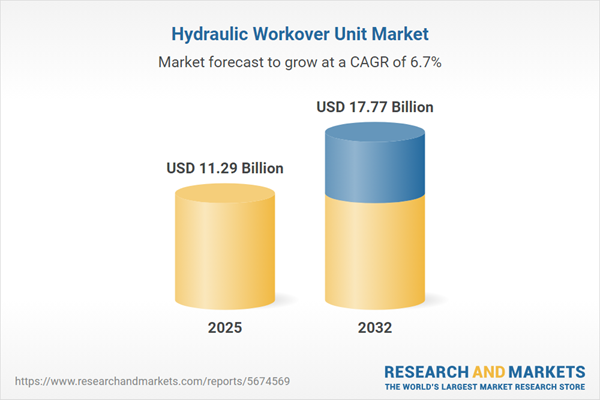Speak directly to the analyst to clarify any post sales queries you may have.
The hydraulic workover unit market is evolving to meet changing executive strategies, with a growing focus on sustainability, digital transformation, and operational resilience. Senior decision-makers are aligning investments towards advanced technology solutions that enhance compliance and operational uptime in a shifting energy landscape.
Market Snapshot: Hydraulic Workover Unit Market Growth
The global hydraulic workover unit market demonstrates steady year-over-year expansion, driven by a robust compound annual growth rate. This sustained growth is underpinned by the industry’s commitment to reliability and sustainability. Leading providers navigate competitive pressures through asset management strategies that incorporate digitalization and energy transition requirements. Regional dynamics influence market trajectories, as varying compliance frameworks and complex supply chain demands shape local approaches. Industry participants are streamlining logistics, strengthening risk management protocols, and fostering collaboration across technical, operational, and supplier teams to maintain business continuity.
Scope & Segmentation of the Hydraulic Workover Unit Market
- Type: Diesel hydraulic workover units remain the preferred choice for established operations seeking familiar reliability and performance. Electric hydraulic workover units are increasingly selected in projects where emissions management and sustainability considerations are procurement priorities.
- Application: Hydraulic workover units serve in proactive well servicing and rapid repair interventions, helping operators achieve consistent uptime and extend asset life during critical production periods.
- End User: The sector supplies independent oil and gas producers, multinational operators, national oil companies, and technical service providers, each striving for efficiency and advanced operational integration.
- Mobility: Skid mounted hydraulic workover units provide stable, long-term deployment options, while truck mounted units enable agile, flexible deployment to suit diverse field environments.
- Regional Coverage: Operators across the Americas, Europe, Middle East, Africa, and Asia-Pacific align with regional regulations and logistics. Each geography presents unique compliance hurdles and creates opportunities for strategies tailored to local needs.
- Featured Companies: Major sector participants include NOV Inc., Schlumberger Limited, Halliburton Company, Baker Hughes Company, Weatherford International plc, Nabors Industries Ltd., Superior Energy Services, Patterson-UTI Energy, Oil States International, and Archer Limited. These firms are enhancing technology and service approaches to meet evolving market demands.
Key Takeaways for Senior Decision-Makers
- Hydraulic workover units are essential for ensuring production continuity in both routine maintenance and complex operational scenarios, supporting asset integrity throughout the lifecycle.
- Integrating modular architectures and digital telemetry significantly improves oversight, bringing efficiencies to both onshore and offshore platforms.
- Adopting predictive maintenance and advanced analytics facilitates early risk identification and minimizes unplanned downtime, safeguarding operational assets.
- Hybrid power solutions and modular system designs empower teams to adjust quickly to varying asset requirements while supporting sustainability commitments.
- Continuous investment in workforce development and adherence to global best practices uphold safety, compliance, and performance standards across dynamic operational contexts.
Tariff Impact on the Hydraulic Workover Unit Market
Recent tariff changes in the United States have raised production and procurement costs for hydraulic workover unit manufacturers and service providers. To counteract these effects, companies are diversifying supplier networks, forming alliances to share risk, and revising sourcing strategies. These proactive measures help support operational resilience and maintain profitability amid evolving regulatory conditions.
Methodology & Data Sources
Insights in this market research report are based on executive interviews, expertise from field engineers and procurement leaders, comprehensive technical analyses, and current regulatory intelligence. Each finding is meticulously cross-verified to provide senior leaders with actionable, trustworthy data for strategic decision-making.
Why This Report Matters
- Presents a systematic approach to guide technology investments, strengthen supplier partnerships, and adapt global strategies as market trends shift.
- Details clear segmentation and technology benchmarks, supporting informed capital allocation and supplier selection aligned with technical goals and geographic priorities.
- Equips management teams to design agile supply chain solutions that address variable tariff pressures and evolving compliance challenges.
Conclusion
This analysis empowers decision-makers to refine operational strategies, foster innovation, and effectively respond to changes shaping the hydraulic workover unit market.
Additional Product Information:
- Purchase of this report includes 1 year online access with quarterly updates.
- This report can be updated on request. Please contact our Customer Experience team using the Ask a Question widget on our website.
Table of Contents
3. Executive Summary
4. Market Overview
7. Cumulative Impact of Artificial Intelligence 2025
Companies Mentioned
The companies profiled in this Hydraulic Workover Unit market report include:- NOV Inc.
- Schlumberger Limited
- Halliburton Company
- Baker Hughes Company
- Weatherford International plc
- Nabors Industries Ltd.
- Superior Energy Services, Inc.
- Patterson-UTI Energy, Inc.
- Oil States International, Inc.
- Archer Limited
Table Information
| Report Attribute | Details |
|---|---|
| No. of Pages | 187 |
| Published | October 2025 |
| Forecast Period | 2025 - 2032 |
| Estimated Market Value ( USD | $ 11.29 Billion |
| Forecasted Market Value ( USD | $ 17.77 Billion |
| Compound Annual Growth Rate | 6.7% |
| Regions Covered | Global |
| No. of Companies Mentioned | 11 |









